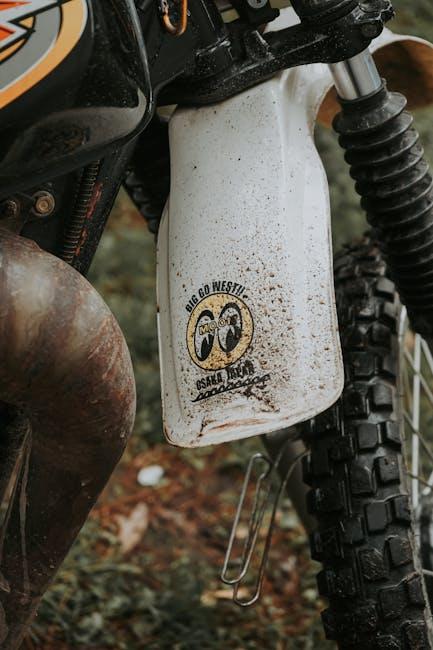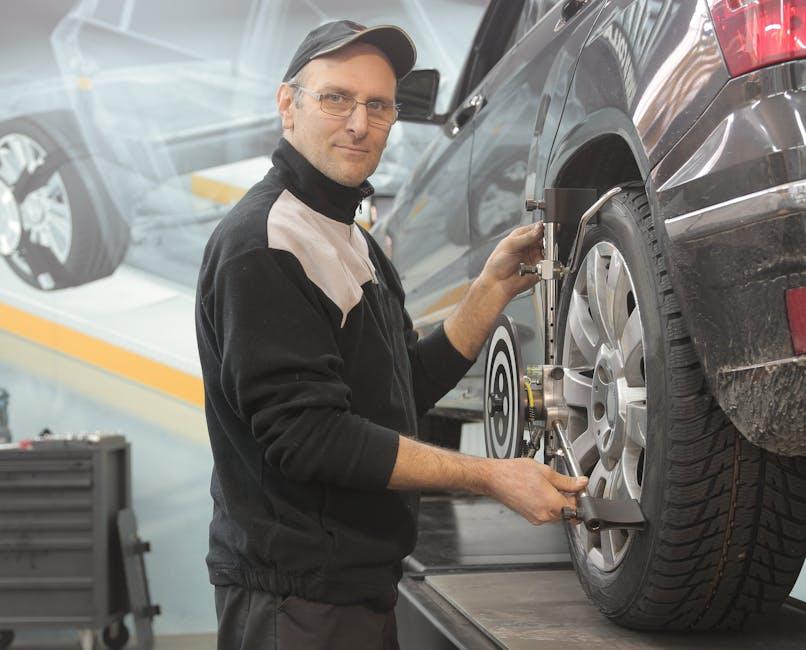Beneath every smooth ride lies a suspension system working tirelessly, absorbing bumps, balancing weight, and maintaining control. Yet, like any intricate mechanism, suspensions can falter, leading to uncomfortable drives and compromised safety. In this article, we delve into common suspension problems—what causes them, how to recognize the signs, and practical fixes that can restore your vehicle’s stability. Whether you’re a seasoned car enthusiast or a curious driver, understanding these issues empowers you to keep your journey steady and secure.
Table of Contents
- Understanding the Signs of Suspension Wear and Tear
- Diagnosing Noises and Vibrations in Suspension Systems
- The Role of Shock Absorbers and How to Maintain Them
- Tackling Uneven Tire Wear Through Suspension Adjustments
- Addressing Alignment Issues for a Smoother Ride
- When to Replace Bushings and Ball Joints for Optimal Performance
- Q&A
- In Summary

Understanding the Signs of Suspension Wear and Tear
Suspension wear doesn’t always scream for attention immediately; oftentimes, the first cues are subtle and easy to miss. Keep an ear out for unusual noises like clunking or squeaking when driving over bumps, which might indicate worn bushings or shock absorbers losing their damping ability. Visual checks can also reveal early signs—look for uneven tire wear, which signals alignment issues possibly caused by suspension components deteriorating unevenly. Additionally, if your vehicle feels unstable or drifts during turns, suspect that the suspension parts, such as ball joints or control arms, could be nearing the end of their life cycle.
- Uneven tire wear: Crooked tire patterns hint at suspension imbalances.
- Vehicle pulling: Car veers to one side even on a flat road.
- Excessive bouncing: The ride feels too soft or shaky after hitting a bump.
- Visual damage: Rust, cracks, or leaks around shocks and springs.
| Symptom | Likely Cause | Immediate Action |
|---|---|---|
| Clunking noises | Worn bushings or loose mounts | Inspect and tighten or replace affected parts |
| Uneven tire wear | Misaligned suspension | Get a professional alignment check |
| Harsh, bouncy ride | Failed shock absorbers | Replace shocks/shocks and struts |

Diagnosing Noises and Vibrations in Suspension Systems
When your vehicle’s suspension starts to emit unusual noises or vibrations, it’s often an early warning sign of underlying issues. Common culprits include worn-out bushings, loose bolts, or damaged shock absorbers. These sounds can range from creaks and clunks to humming or grinding, each indicating different potential problems. For instance, a squeaking noise when turning might point to dried or failing ball joints, while rumbling vibrations felt through the steering wheel could signify wheel bearing wear.
To systematically diagnose these problems, begin with a thorough visual inspection and listen carefully while driving at various speeds. Use this quick reference guide to pinpoint common symptoms:
- Creaking or squeaking: Dry or cracked bushings
- Clunking or knocking: Loose or worn control arms
- Grinding: Damaged shock absorbers or struts
- Vibration in steering wheel: Worn wheel bearings or uneven tire wear
| Symptom | Likely Cause | Suggested Fix |
|---|---|---|
| Creaking during turns | Dry or failing ball joints | Lubricate or replace ball joints |
| Clunk noises over bumps | Worn control arm bushings | Replace bushings |
| Continuous vibration | Imbalanced tires or bad shocks | Balance tires; inspect shocks |

The Role of Shock Absorbers and How to Maintain Them
Shock absorbers play a crucial role in smoothing out your ride by dampening the impact of bumps and irregularities on the road. They work tirelessly to control the rebound of your suspension springs, preventing excessive bouncing that can compromise vehicle stability and passenger comfort. Without well-functioning shock absorbers, drivers face reduced traction, longer stopping distances, and uneven tire wear, which can escalate into costly damage over time.
Maintaining these vital components requires regular inspections and simple habits that extend their lifespan. Look out for signs such as:
- Unusual noises when driving over bumps
- Visible oil leaks around the shock body
- Excessive bouncing or nose-diving when braking
Routine checks every 12,000 miles or sooner if you often drive on rough roads will help catch issues early. When replacing shock absorbers, consider matching them with your vehicle’s specific handling needs to ensure a smooth, controlled ride every time.
| Shock Absorber Type | Best For | Maintenance Tips |
|---|---|---|
| Hydraulic | Everyday driving | Check oil levels and replace every 50k miles |
| Gas-charged | Sporty handling | Inspect seals, avoid harsh impacts |
| Adjustable | Custom setups | Fine-tune settings regularly, inspect for leaks |

Tackling Uneven Tire Wear Through Suspension Adjustments
Uneven tire wear is often an overlooked symptom of underlying suspension issues. When your suspension components are out of alignment or worn out, they cause inconsistent contact between the tire and the road. This leads to patches of the tire tread wearing faster than others, ultimately shortening the lifespan of your tires and compromising vehicle safety. By fine-tuning the suspension settings, such as camber, toe, and caster angles, you restore proper tire alignment, ensuring even pressure distribution across the tire surface. This adjustment not only improves tire longevity but also enhances handling, fuel efficiency, and overall driving comfort.
Addressing this issue involves more than just changing the tires—it’s about examining the suspension holistically. Here are the key suspension aspects to inspect and adjust to combat uneven tire wear:
- Wheel Alignment: Realigning wheels to manufacturer specifications is the cornerstone of even tire wear.
- Shock Absorbers and Struts: Replacing worn components restores vehicle stability, aiding in consistent tire contact.
- Ball Joints and Bushings: Ensuring these parts are intact prevents irregular tire movement and wear patterns.
| Suspension Component | Effect on Tire Wear | Recommended Action |
|---|---|---|
| Camber Angle | Inner or outer edge wear | Adjust alignment to correct camber |
| Toe Setting | Feathered tread wear | Fine-tune toe for straight tracking |
| Shock Absorbers | Patchy tire wear due to bounce | Replace if leaking or damaged |

Addressing Alignment Issues for a Smoother Ride
When your vehicle pulls to one side or the steering wheel doesn’t sit center, it’s often a sign that your suspension alignment is off. Proper alignment ensures all wheels point in the right direction, distributing weight evenly and enhancing tire wear patterns. Ignoring these subtle shifts can result in uneven tire wear, increased fuel consumption, and uncomfortable handling that turns every drive into a challenge. Ensuring alignment adjustments are made by a professional can restore harmony between your vehicle’s suspension components and the road.
Common signs that indicate a misalignment include:
- Uneven tire wear: Tires show more wear on one edge than the other
- Steering wheel off-center: The wheel isn’t straight when driving on a flat road
- Vehicle pulling: The car slowly drifts to the left or right
- Vibration in the steering wheel: Often felt when driving at higher speeds
| Symptom | Possible Cause | Recommended Action |
|---|---|---|
| Tire edges wearing unevenly | Incorrect camber or toe settings | Get a wheel alignment check and adjustment |
| Steering wheel not centered | Misaligned steering components | Realign steering and suspension system |
| Vehicle pulling to one side | Unequal tire pressure or alignment issues | Check tire pressure and perform alignment |

When to Replace Bushings and Ball Joints for Optimal Performance
Recognizing the right time to replace bushings and ball joints is crucial for maintaining your vehicle’s smooth handling and overall safety. Over time, bushings made of rubber or polyurethane start to crack, wear, or become brittle due to constant stress and exposure to the elements. Similarly, ball joints—vital pivot points connecting the suspension to the wheels—can wear out, causing play, noise, and uneven tire wear. If you notice symptoms such as excessive vibrations, clunking noises when driving over bumps, or your car pulling to one side, it’s a clear signal these parts need inspection. Regularly checking these components, especially after logging significant mileage or experiencing rough driving conditions, helps you stay ahead of costly repairs.
To help you decide when to replace these suspension components, consider the following signs and their impact on performance:
- Worn Bushings: Increased engine and road vibrations, loose steering feel, and squeaking noises.
- Failing Ball Joints: Clunking while turning, uneven tire wear patterns, and looseness in the steering wheel.
- Visual Damage: Cracks, tears, or missing rubber material around bushings; rust or excessive play in ball joints.
| Component | Common Symptoms | Replacement Interval |
|---|---|---|
| Bushings | Vibrations, loose handling | Every 60,000-100,000 miles |
| Ball Joints | Clunking, uneven tires | 50,000-90,000 miles (varies) |
Q&A
Q&A: Common Suspension Problems and Fixes
Q1: What are the most common signs that my vehicle’s suspension is failing?
A: Look out for unusual tire wear, a bouncy or shaky ride, uneven steering response, and clunking noises when driving over bumps. If your car leans excessively when turning or dips noticeably when braking, your suspension is likely in need of attention.
Q2: Why does my car feel bouncy after hitting a pothole?
A: A bouncy ride often indicates worn-out shock absorbers or struts. These components control how your vehicle reacts to bumps and dips on the road. When they lose their damping ability, the car can bounce excessively, reducing comfort and safety.
Q3: What causes uneven tire wear related to suspension issues?
A: Suspension problems like misaligned wheels, worn ball joints, or damaged control arms can cause tires to wear unevenly. This happens because the tires don’t maintain consistent contact with the road, leading to patchy tread wear and premature tire replacement.
Q4: How can I tell if my suspension bushings are bad?
A: Faulty bushings often manifest as clunking sounds when driving over rough roads or during sharp turns. You might also experience loose or imprecise steering. Visually, cracked or deteriorated rubber in the bushings signals they need replacing.
Q5: Are suspension repairs expensive?
A: The cost varies widely depending on the issue. Minor fixes like replacing bushings or shock absorbers are more affordable, while major repairs involving control arms, struts, or complete suspension overhauls can be pricier. Regular maintenance helps catch problems early and keeps costs down.
Q6: Can I drive with a damaged suspension?
A: It’s not advisable. A compromised suspension affects vehicle handling, braking efficiency, and overall safety. Continuing to drive can cause further damage and increase the risk of accidents.
Q7: What are some DIY fixes for common suspension problems?
A: Simple tasks like checking and adjusting tire pressure, inspecting visible bushings for wear, or tightening loose bolts can sometimes help. However, most suspension repairs require professional tools and expertise, especially for alignment and component replacement.
Q8: How often should I have my suspension checked?
A: It’s a good idea to have your suspension inspected during routine maintenance visits—typically every 12,000 to 15,000 miles or once a year. If you notice any handling issues or unusual noises, get it checked sooner.
Q9: Can aftermarket suspension upgrades improve common problems?
A: Yes, upgrading shocks, springs, or bushings to higher-quality aftermarket parts can enhance ride comfort, stability, and durability. Just ensure the parts are compatible with your vehicle and professionally installed.
Q10: What preventative steps can I take to prolong my suspension’s life?
A: Drive carefully over rough roads, avoid potholes when possible, keep your tires properly inflated and balanced, and schedule regular suspension inspections. These habits minimize wear and help catch issues before they become costly repairs.
In Summary
In the intricate dance between your vehicle and the road, the suspension system plays the starring role—absorbing bumps, maintaining balance, and ensuring a smooth ride. While common suspension problems can disrupt this harmony, understanding their signs and remedies empowers you to stay in control. Remember, a well-maintained suspension not only enhances comfort but also fortifies safety on every journey. So next time your ride feels a little offbeat, consider these fixes your roadmap back to a steady, confident drive. Safe travels!


5 Comments
e55i1h
e55i1h
5ttdrm
nrli8i
h69ohi